Overview
The top five 3-day dumbbell split routines for maximum muscle gain are designed with structured workouts that specifically target different muscle groups. This approach not only enhances strength but also promotes hypertrophy through focused training sessions. These routines encompass:
- Upper body
- Lower body
- Push
- Pull
- Combined workouts
Furthermore, they are supported by research demonstrating their effectiveness in increasing muscle mass and strength. Importantly, these routines are adaptable for various fitness levels, making them accessible to a wide range of individuals.
Introduction
In the pursuit of fitness, the 3-day dumbbell split routine stands out as a formidable strategy for achieving strength and muscle growth. This structured approach enables individuals to concentrate on specific muscle groups, facilitating targeted training and optimal recovery.
With dedicated sessions for:
- Upper body
- Lower body
- Push-pull exercises
This regimen not only enhances physical performance but also supports mental well-being and productivity. Research substantiates the effectiveness of such split routines, demonstrating significant gains in strength and muscle hypertrophy compared to traditional total-body workouts.
As awareness of the dual benefits of physical fitness and workplace motivation increases, the adaptability of the 3-day dumbbell split routine positions it as a compelling choice for fitness enthusiasts at all levels. By embracing this method, individuals can maximize their training efforts and efficiently work towards achieving their fitness goals.
Understanding the 3-Day Dumbbell Split Routine
A 3-day dumbbell split routine is a structured workout plan that strategically targets different muscle groups on separate days, facilitating focused training and optimal recovery. This method generally includes three sessions per week, each dedicated to specific body groups—often categorized into upper body, lower body, and a mix of push and pull exercises. By concentrating on fewer groups per session, individuals can achieve higher intensity and volume, essential for promoting hypertrophy and enhancing muscle gains.
Studies indicate that split workouts significantly impact hypertrophy. A notable study comparing two weekly total-body sessions to four weekly split-body sessions found that the latter resulted in greater increases in strength and muscle mass among untrained women. This highlights the importance of exercise frequency in resistance programs, suggesting that a well-organized split schedule can yield superior results.
As Helene Pedersen noted, "The results from the present study indicate that two longer sessions are just as effective as four shorter sessions per week."
In 2025, statistics reveal that employees who engage in regular exercise—specifically, those who work out for at least 30 minutes three times per week—report higher motivation levels at work. This correlation underscores the broader benefits of incorporating a 3-day dumbbell split into one’s fitness regimen, as it not only fosters physical health but also enhances mental well-being and productivity. Furthermore, Dr. Pak Androulakis-Korakakis emphasizes the importance of exercise frequency, stating that his research focuses on the 'minimum effective exercise dose for strength,' aligning with the principles of split routines.
The adaptability of the 3-day dumbbell split training plan makes it suitable for various fitness levels, from beginners to advanced lifters. This flexibility allows individuals to customize their workouts based on their specific objectives and abilities, ensuring that everyone can benefit from this effective exercise method. Additionally, fitness instructors highlight the significance of recovery in split workouts, noting that sufficient rest between sessions is crucial for optimizing results and avoiding injury.
In summary, a 3-day dumbbell split program offers numerous benefits for strength development, including focused workouts, heightened intensity, and enhanced recovery. By investing in this organized method, individuals can enhance their exercise efforts and achieve their fitness objectives more effectively. This aligns with Corporate Membership - Contact Our Health Coaches Today's mission to promote employee well-being and productivity through our comprehensive wellness coaching app, which provides personalized workouts, nutrition guidance, daily programming, and community engagement.
With direct support from coaches, users can stay on track with their health goals while benefiting from motivation and encouragement from a supportive community.
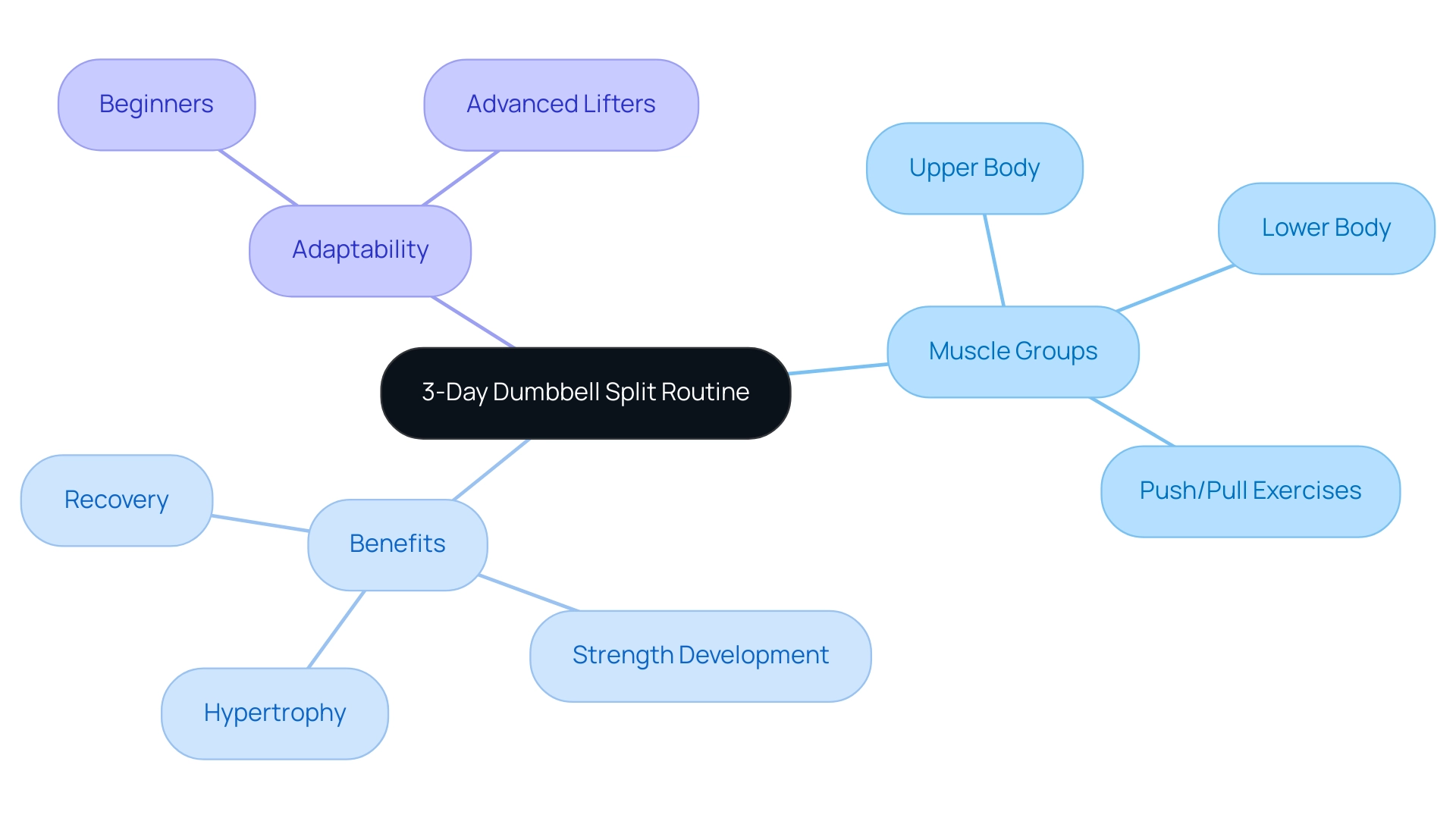
Routine 1: Upper Body Focus for Strength and Hypertrophy
The upper body exercise program is designed to target essential muscle groups, including the chest, back, shoulders, and arms, ensuring a balanced approach to strength training. A well-structured sample workout might include:
- Dumbbell Bench Press: 4 sets of 8-12 reps
- Bent-Over Dumbbell Row: 4 sets of 8-12 reps
- Dumbbell Shoulder Press: 3 sets of 10-15 reps
- Dumbbell Bicep Curl: 3 sets of 10-15 reps
- Dumbbell Tricep Extension: 3 sets of 10-15 reps
This routine emphasizes compound movements, which are crucial for engaging multiple muscle groups simultaneously. Research indicates that compound exercises not only enhance muscle growth but also improve overall athletic performance. For instance, studies have shown that upper body power significantly correlates with performance in high-intensity activities such as sprinting and jumping, highlighting the importance of a strong upper body in various athletic endeavors.
In 2025, the benefits of upper body strength training continue to be underscored by statistics revealing that individuals who engage in regular strength training experience improved job performance, creativity, and stress management. Significantly, individuals who include upper body exercises in their schedules report higher motivation levels at work, with a marked increase in productivity and engagement.
Success stories abound for those who have embraced dumbbell routines for hypertrophy. Many individuals have achieved remarkable muscle gains by consistently following structured upper body workouts. For instance, a recent case study involving a group of athletes showed that focused upper body conditioning resulted in notable enhancements in their performance metrics, including improved jumping ability and overall athleticism.
This case study demonstrates the direct advantages of upper body conditioning on athletic performance, especially in activities that require explosive power.
Moreover, trunk extensors have been shown to contribute to drop jump performance, further emphasizing the importance of upper body strength in athletic endeavors. Expert insights highlight the necessity of consistency in preparation. As noted, "Consistency is essential, but if you don't notice changes after about eight weeks, you are not training hard enough and need to mix up your routine by increasing your weight or sets or the number of exercises."
This emphasizes the significance of progressive overload in attaining desired growth in strength.
In summary, a well-rounded upper body workout that follows a 3-day dumbbell split not only promotes power and hypertrophy but also contributes to overall physical fitness and workplace productivity. By incorporating these exercises into a consistent training routine like a 3-day dumbbell split, individuals can optimize their development and improve their athletic performance. Future research is needed to further explore the relationship between upper body power and various athletic performances, including jumping and change of direction abilities.
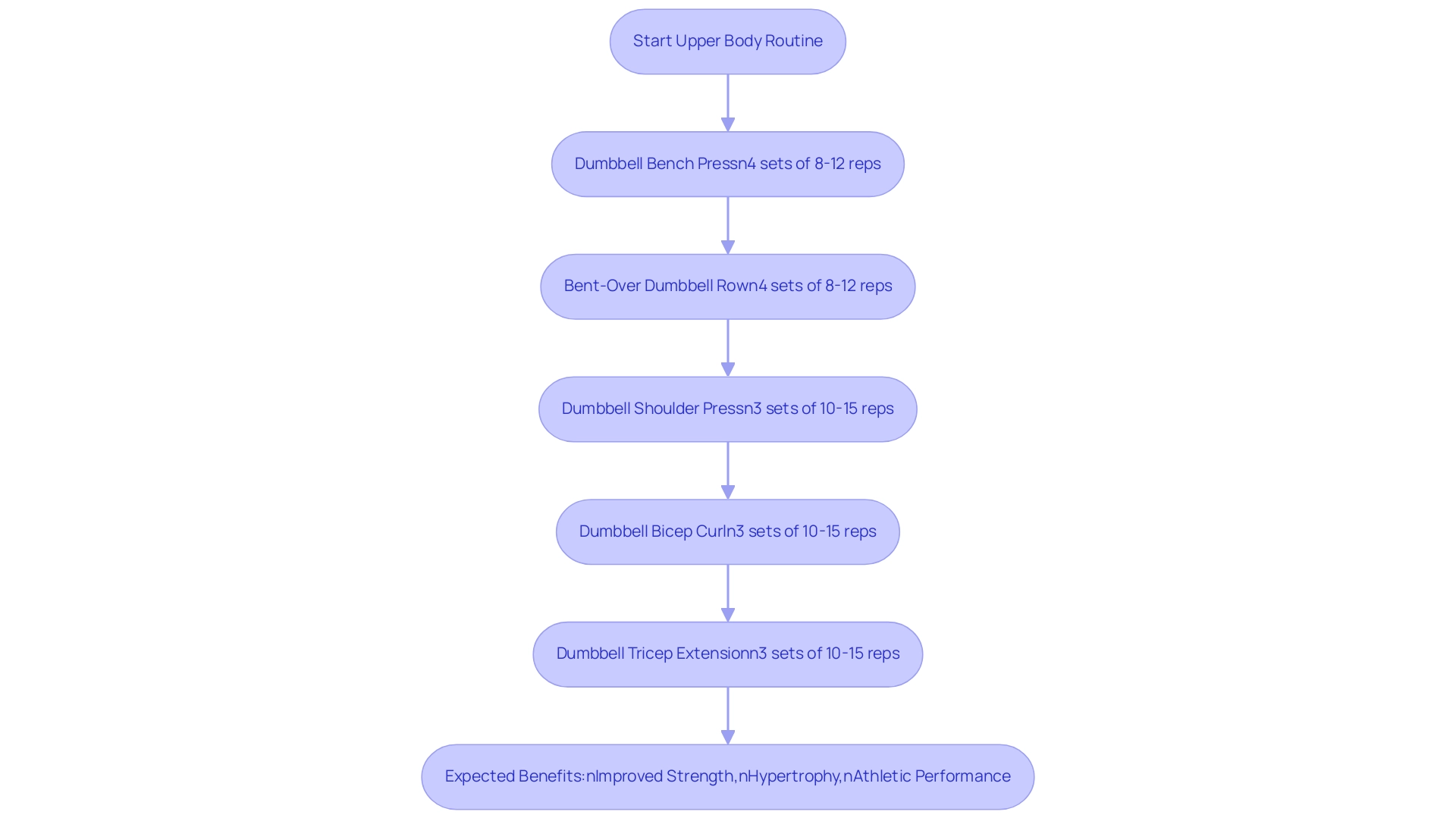
Routine 2: Lower Body Strength and Muscle Building
The lower body workout is designed to effectively target the quadriceps, hamstrings, glutes, and calves, promoting both muscle growth and functional power. A well-structured workout may comprise:
- Dumbbell Squats: 4 sets of 8-12 reps
- Dumbbell Deadlifts: 4 sets of 8-12 reps
- Dumbbell Lunges: 3 sets of 10-15 reps per leg
- Dumbbell Calf Raises: 3 sets of 12-15 reps
This routine not only facilitates muscle development but also enhances functional strength, which is crucial for daily activities and overall athletic performance. Research indicates that engaging in lower body exercises can significantly improve functional capability, with studies revealing that resistance workouts can lead to a 7.2% increase in lower-body power each week for young women. Furthermore, regular resistance training is linked to a better quality of life, reduced risk of chronic illnesses, and improved sleep quality, establishing it as an essential component of a balanced fitness regimen.
Dumbbell squats and deadlifts are fundamental exercises that contribute to mass and functional power development. These movements not only strengthen the lower body but also enhance core stability and overall body mechanics. As Dr. Jacob Erickson, a Sports Medicine Physician at the Mayo Clinic, states, "Resistance exercises will actually reinforce the tissues," which is vital for performing daily activities and enhancing athletic performance.
Recent studies underscore the benefits of lower body power workouts, indicating that consistent participation in these activities can yield significant improvements in muscle mass and functional abilities. Moreover, the importance of resistance exercise for maintaining overall health and preventing injuries cannot be overstated, as research demonstrates its role in improving functional independence and combating the aging process. Statistics show that resistance exercise can reduce the likelihood of nursing home admissions by 84% in older adults recovering from hip fractures, highlighting its profound impact on health and mobility.
Incorporating a lower body dumbbell exercise into your three-day dumbbell split fitness plan is a strategic approach to developing power and enhancing overall physical performance, ensuring that you are well-prepared for both athletic endeavors and everyday life.
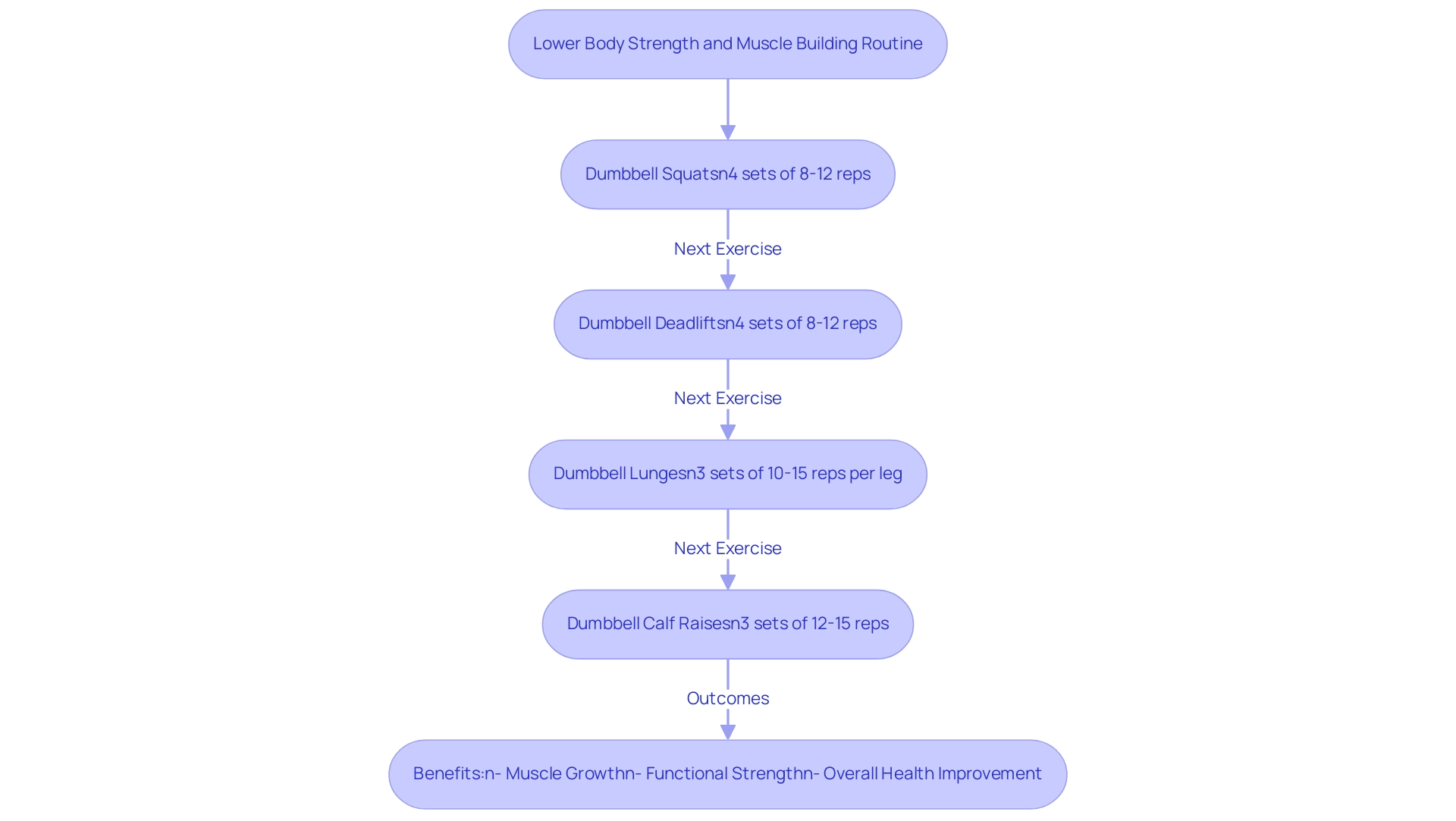
Routine 3: Push Day for Enhanced Muscle Growth
The push day regimen is designed to effectively target the chest, shoulders, and triceps, establishing itself as a cornerstone of any training program. A well-structured sample workout might include:
- Dumbbell Bench Press: 4 sets of 8-12 reps
- Dumbbell Shoulder Press: 4 sets of 8-12 reps
- Dumbbell Flyes: 3 sets of 10-15 reps
- Dumbbell Lateral Raises: 3 sets of 10-15 reps
This routine strategically combines compound and isolation exercises, which are essential for maximizing muscle growth and enhancing upper body strength. Compound exercises, such as the dumbbell bench press and shoulder press, engage multiple muscle groups, thereby improving overall strength and stability. Conversely, isolation exercises like dumbbell flyes and lateral raises concentrate on specific muscles, facilitating targeted development.
Mark Van Putte, a sports and fitness enthusiast, asserts that 'to make the most of your push day regimen, you need to incorporate the right exercises.' Recent studies underscore the effectiveness of push exercises in resistance training, revealing that push-pull workout patterns are proven methods for developing muscular power across various fitness levels. A 2021 study titled "Effectiveness of Push-Pull Workouts" highlighted significant strength gains among participants, irrespective of their prior fitness experience.
Moreover, leveraging our health coaching app, Corporate Membership - Contact Our Health Coaches Today, can elevate your push day regimen by delivering personalized workouts, nutrition guidance, daily programming, video demonstrations, and movement flows tailored to your specific goals. The app's features, including direct messaging with coaches for personalized support and community engagement for motivation, ensure that you have all the resources you need in one centralized location. Statistics indicate that employees who engage in regular exercise, such as a push day workout, for at least 30 minutes three times per week are more likely to report heightened motivation at work.
This motivation can translate into increased productivity and job satisfaction, making a compelling case for incorporating structured exercise plans into daily routines. Furthermore, adjusting physical movement and repetition speed can enhance training efficiency and effectiveness, further optimizing the push day regimen.
In summary, the push day workout not only fosters growth but also contributes to overall well-being, reinforcing the importance of a balanced fitness regimen and its positive impact on workplace motivation and productivity. Download our app today to embark on your journey toward achieving your health goals efficiently!
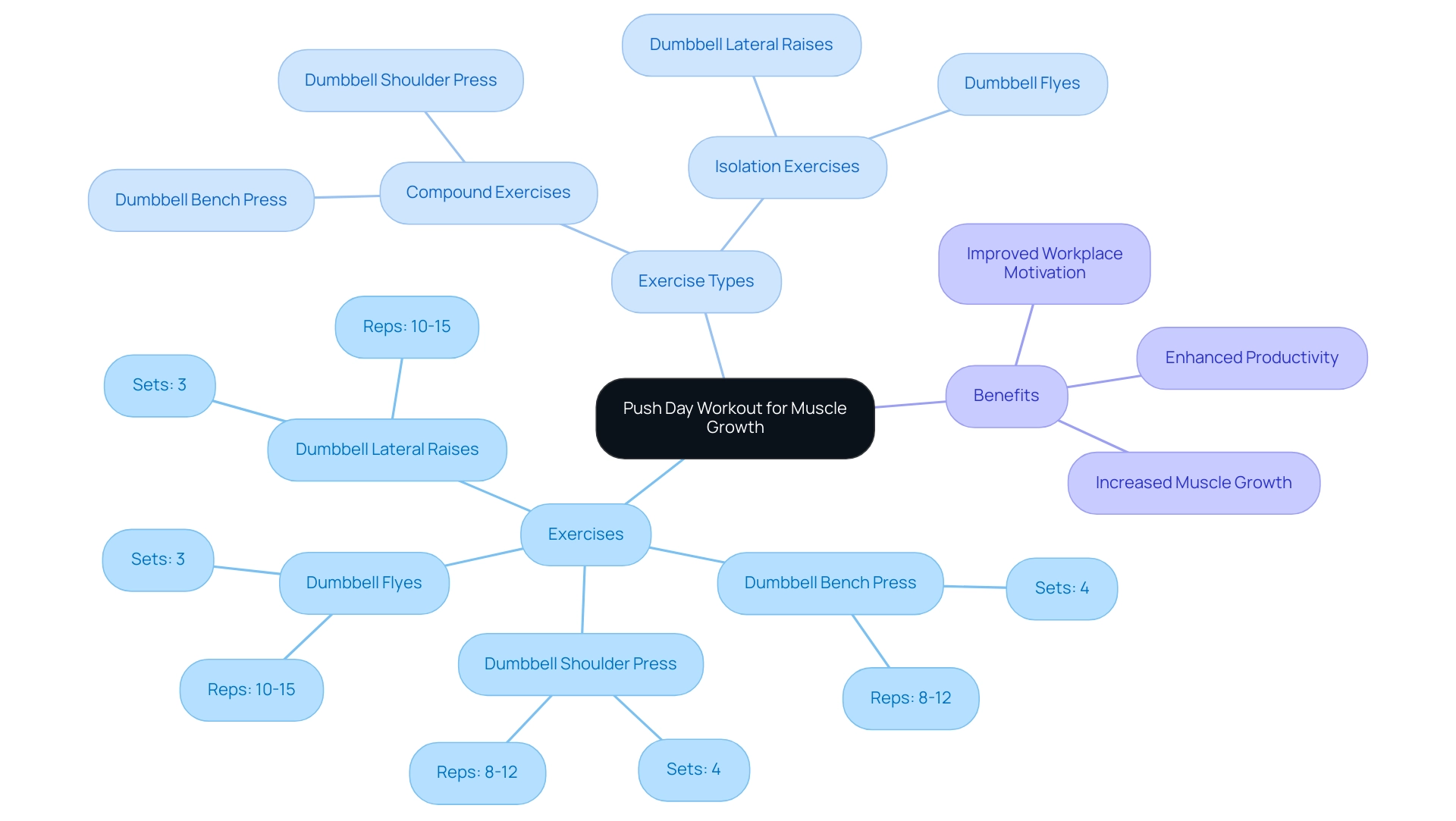
Routine 4: Pull Day for Comprehensive Muscle Development
The pull day program is meticulously designed to effectively target the back, biceps, and rear shoulders, playing a crucial role in improving overall upper body power and posture. A well-organized sample workout could include:
- Dumbbell Bent-Over Rows: 4 sets of 8-12 reps – This exercise is pivotal for developing the latissimus dorsi and enhancing overall back thickness.
- Dumbbell Pullovers: 3 sets of 10-15 reps – Pullovers engage the lats while also working the chest and triceps, promoting a balanced upper body workout.
- Dumbbell Bicep Curls: 3 sets of 10-15 reps – A staple for bicep development, curls enhance definition and power in the arms.
- Dumbbell Face Pulls: 3 sets of 10-15 reps – This exercise targets the rear deltoids and upper back, crucial for shoulder stability and posture.
Incorporating these exercises into a 3-day dumbbell split is essential for fostering comprehensive physical development. Recent studies indicate that focused exercises for the back and biceps can lead to significant enhancements in upper body power. For instance, research demonstrates that individuals participating in organized pull day workouts experience improved activation and growth of their tissues, with some noting a 2.1 mm (10.5%) increase in thickness in the vastus lateralis, underscoring the effectiveness of targeted resistance training.
Furthermore, expert perspectives underscore the significance of pull day routines in developing a robust upper body. Daniel J. Green, Senior Project Manager and Editor for Publications and Content Development at ACE, emphasizes that organized instruction is vital for fitness professionals and can significantly impact overall performance.
By consistently performing these exercises as part of a 3-day dumbbell split, individuals can anticipate not only improved strength but also enhanced posture and reduced risk of injury, making it a vital component of any strength training regimen.
For those with limited training time, it is advisable to focus on specific warm-ups for the first exercise of each group, ensuring that the body is adequately prepared for the workout. Additionally, understanding the differences in muscle activation between pull-ups and chin-ups can provide a more comprehensive approach to the exercises included in the pull day routine. By integrating these elements, organizations can foster a culture of health and productivity, ultimately enhancing employee performance and well-being.
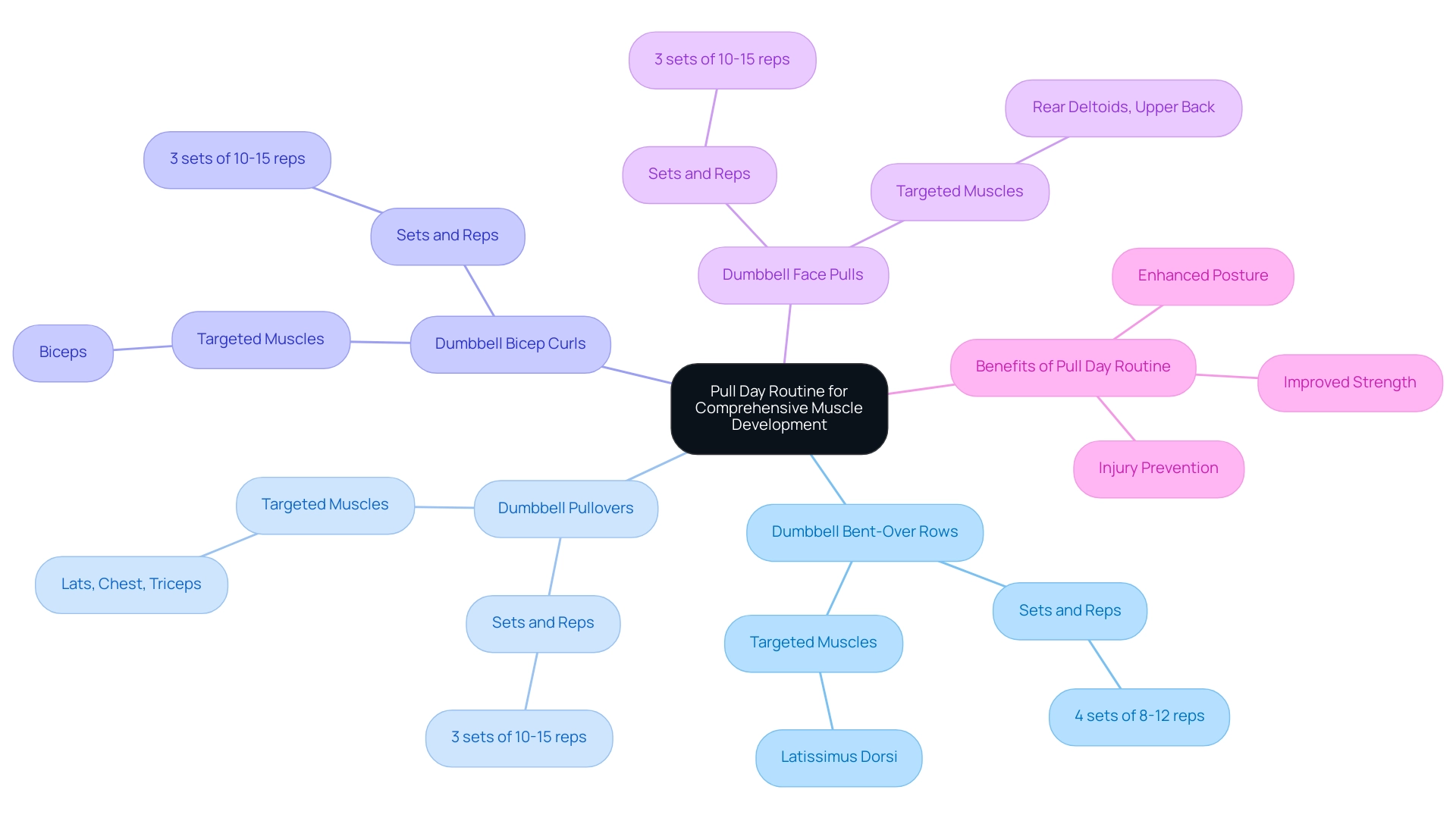
Conclusion
The 3-day dumbbell split routine stands as a powerful and efficient approach to fitness, offering a structured method for targeting specific muscle groups while allowing for optimal recovery. By dividing workouts into upper body, lower body, and push-pull sessions, individuals can focus their training intensity and volume, leading to significant gains in strength and muscle hypertrophy. This targeted strategy not only promotes physical growth but also enhances mental well-being, as regular exercise has been linked to increased motivation and productivity in the workplace.
Research supports the effectiveness of this regimen, highlighting its superiority over traditional total-body workouts in achieving fitness goals. The adaptability of the 3-day dumbbell split routine makes it accessible to all fitness levels, ensuring that everyone can benefit from its structured approach. With an emphasis on adequate recovery and progressive overload, individuals can maximize their training efforts and realize substantial improvements in their physical performance.
Incorporating this routine into a fitness regimen can lead to a healthier lifestyle, improved functional strength, and enhanced athletic performance. As the importance of physical fitness continues to grow in today’s fast-paced environment, embracing the 3-day dumbbell split routine can be a transformative step towards achieving long-term health and wellness goals. By prioritizing structured strength training, individuals set themselves on a path to not only meet their fitness objectives but also enhance their overall quality of life.
Frequently Asked Questions
What is a 3-day dumbbell split routine?
A 3-day dumbbell split routine is a structured workout plan that targets different muscle groups on separate days, typically focusing on upper body, lower body, and a mix of push and pull exercises. This method allows for higher intensity and volume in workouts, promoting hypertrophy and muscle gains.
How does a 3-day dumbbell split routine benefit muscle growth?
Studies indicate that split workouts significantly impact hypertrophy. Research comparing total-body sessions to split-body sessions found that split routines led to greater increases in strength and muscle mass, particularly among untrained women, highlighting the importance of exercise frequency in resistance training.
What is the recommended frequency of workouts in a 3-day dumbbell split routine?
The routine generally includes three sessions per week, allowing for focused training and optimal recovery between sessions.
Are there specific benefits of engaging in a 3-day dumbbell split routine for overall well-being?
Yes, individuals who engage in regular exercise, such as a 3-day dumbbell split, report higher motivation levels at work and improved mental well-being, which can enhance productivity.
Is the 3-day dumbbell split routine suitable for all fitness levels?
Yes, the 3-day dumbbell split training plan is adaptable and suitable for various fitness levels, from beginners to advanced lifters, allowing for customization based on individual objectives and abilities.
Why is recovery important in a 3-day dumbbell split routine?
Sufficient rest between sessions is crucial for optimizing results and avoiding injury, as it allows the body to recover and rebuild muscle tissue effectively.
What are some examples of exercises included in the upper body program of a 3-day dumbbell split?
A well-structured upper body workout may include exercises such as Dumbbell Bench Press, Bent-Over Dumbbell Row, Dumbbell Shoulder Press, Dumbbell Bicep Curl, and Dumbbell Tricep Extension, focusing on compound movements to engage multiple muscle groups.
How does upper body strength training impact athletic performance?
Research shows that upper body strength significantly correlates with performance in high-intensity activities, such as sprinting and jumping, emphasizing its importance in various athletic endeavors.
What is the significance of consistency in a dumbbell training routine?
Consistency is essential for achieving desired results, and if no changes are noticed after about eight weeks, it may indicate the need to increase weights, sets, or exercises to ensure progressive overload and continued growth in strength.
How does a 3-day dumbbell split routine contribute to workplace productivity?
Regular strength training, including upper body exercises, has been associated with improved job performance, creativity, and stress management, leading to higher motivation levels and productivity at work.

